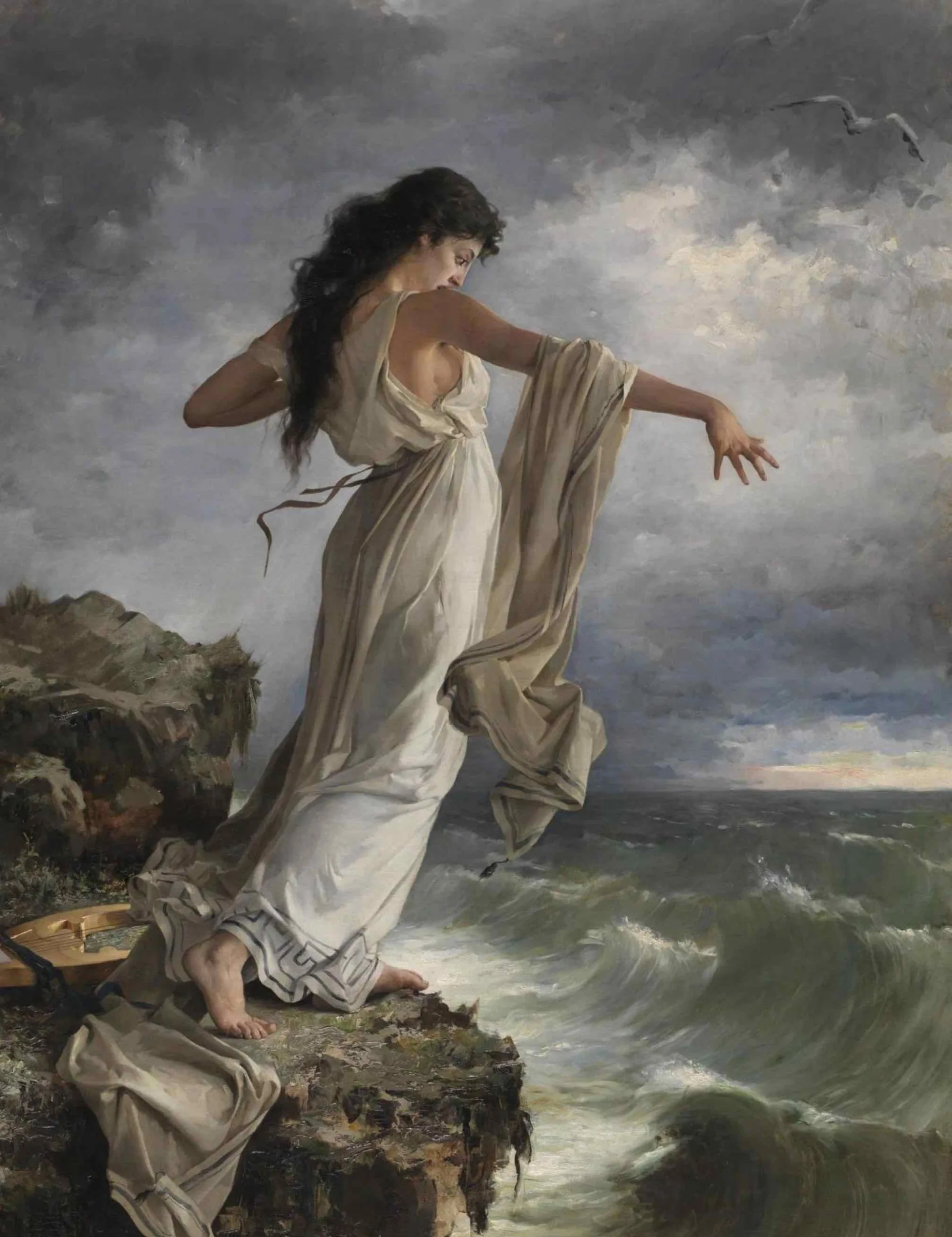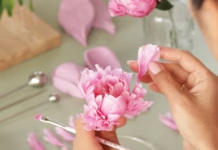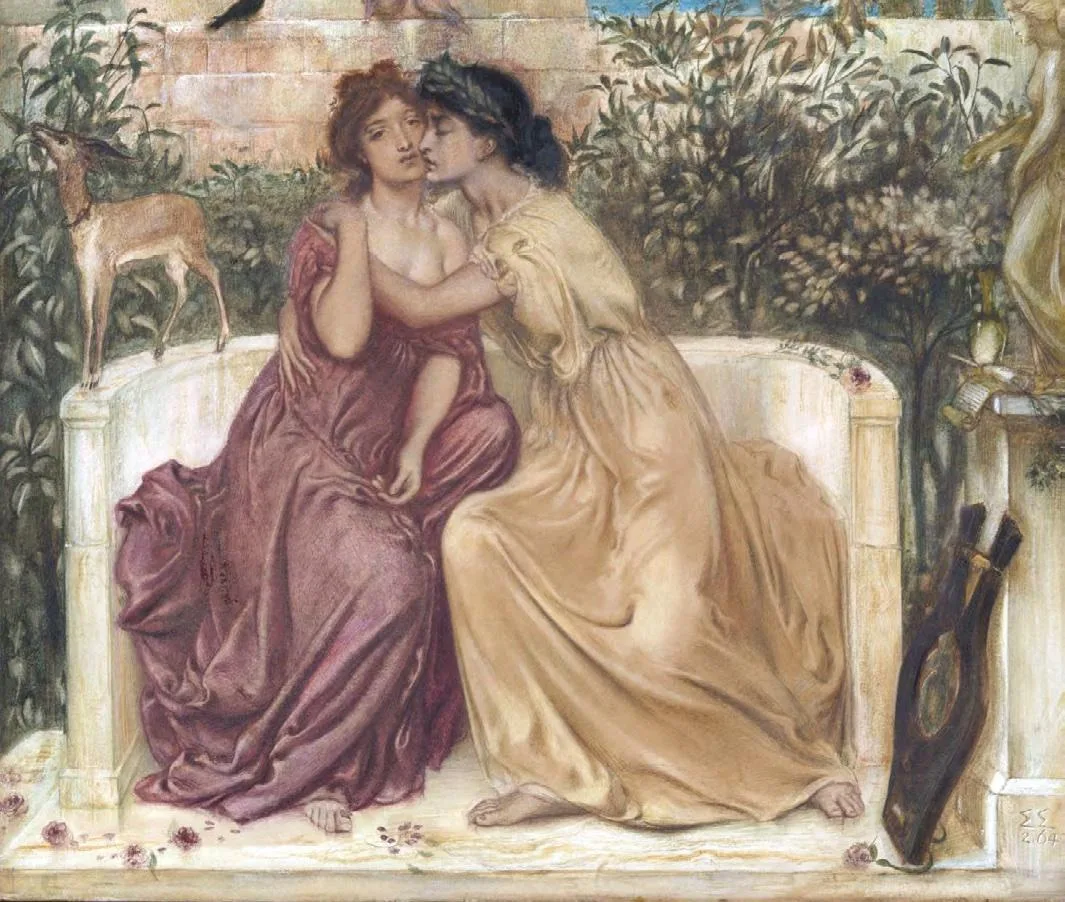Feature Image:
Sappho and Erinna in a Garden at Mytilene (1864), by Simeon Solomon
According to the Ancient Greek poet Alcaeus of Mytilene, “No man sings like a Lesbian singer.” A very progressive statement for 600 B.C., but he was actually speaking of the magic and beauty of the lyric poets of the island of Lesbos and, more particularly, of his contemporary Sappho. Possibly the most heralded singer-songwriter of pre-Christian times, Sappho is mainly remembered today for her love of the ladies, as so little of her poetry survives. Yet for a woman who literally gave her name to a euphemism for female gayness, she wrote an awful lot of lust poems about men as well and even apparently threw herself off a cliff because a man didn’t love her. All this complication leads me to Sappho’s unexpected heyday, the 19th century, where this magical Greek poet by necessity became all these things and more.
Let’s start with who Sappho was. As someone who lived around six hundred years before Christ, she didn’t leave a lot of personal information, but we know that she wrote lyric poetry that was intended to be sung with accompanying music and that her work was so popular that she was christened the “Tenth Muse.” Much of what we know about Sappho is inferred from her poems, as the earliest biography of her wasn’t written until nearly 800 years after her death. Most of her poetry is now lost, however, with only fragments and one complete poem, the famous “Ode to Aphrodite,” surviving. But such was the power of her reputation and the lines that were discovered that she remained in the canon for centuries. Then along came the Victorians, for whom she would personify all aspects of womanhood. Do you want a talented poetess whose work has transcended centuries? Do you want a decadent lover, whose queerness knows no shame? Do you fancy a suicidal, spurned tragic heroine? A love witch with incantations for her errant lovers? There is a Sappho for every occasion—but how many of them were figments of the 19th century imagination?
The Victorians loved the classical period. Painters joyously placed wistful figures on cold marble benches, draped in flimsy fabric. In Sappho, they found the perfect subject onto which they could project all the ideas of the civilized intellect that the homogenous “classics” evoke. In Sappho at Mytilene (1876), Pierre Coomans shows bevies of classical beauties listening to Sappho while offering her laurel crowns. Similarly, John William Godward’s 1904 Sappho of Lesbos shows a buxom woman wrapped in diaphanous fabrics, sensibly sitting on a fur rug—I’m guessing marble is a tad cold, especially first thing in the morning. In Lawrence Alma-Tadema’s 1881 Sappho and Alcaeus, the painter, well-known for his classical scenes, places the two poets together, with Sappho leaning forward in contemplation as she listens to her contemporary’s song. These images are like corporate portraits: Sappho at work as an intellectual, among her peers who respect and celebrate her. It’s unsurprising that poets such as Felicia Hemans, Katherine Bradley, and Edith Cooper (who wrote under the male pseudonym Michael Fields) wrote in praise of their sister poetess.

Not that there weren’t scores of male poets who also aligned themselves with Sappho. Most famous among them was Algernon Swinburne, whose extremely florid verse envisaged “the Lesbians kissing across their smitten / Lutes with lips more sweet than the sound of lute-strings.”
Possibly what Swinburne was imagining in “Sapphics” (1866) was an 1864 painting by Simeon Solomon, Sappho and Erinna in a Garden at Mytilene. In this work, Sappho is not kissing her beloved Erinna across her smitten lute; she has instead sensibly put her instrument to one side. No one wants a lute awkwardly poked in their ribcage during an embrace.
Solomon in turn was apparently inspired by Swinburne’s earlier poems about the life and loves of Sappho, including
of her fellow poet Erinna. In Sappho’s own poem “Ode to Aphrodite,” the poet calls upon the goddess to make the girl she desires fall in love with her. In return Aphrodite recites an incantation, some love magic that will win her heart: “She who shuns love soon will pursue it, / She who scorns gifts will send them still: / That girl will learn love, though she do it / Against her will.” In Solomon’s painting, it’s noticeable that Sappho seems far more enamored of Erinna, leaning in, eyes closed. Erinna, by contrast, just sort of sits there, not really getting involved. It is tempting to think that Sappho was calling for help from Aphrodite because Erinna was just not that into her. Here, however, we encounter the main problem with Erinna and Sappho’s relationship: They never met. Erinna played very hard to get by being born a few centuries after Sappho’s death. Sappho undoubtedly sang to Aphrodite about the love of a girl, or possibly a few girls, but who they were remains unknown.
Another problem with the well-known Lesbian is that she also wrote about her love of boys. In my favorite of her fragments, she foreshadows Charli XCX’s 2017 lyrical ballad “Boys,” telling her mother she can’t possibly do any weaving today as she is busy thinking ’bout boys …
I can’t take the shuttle in hand,
There is a boy, and lust
Has crushed my spirit …

This bisexuality could well have come from some overzealous translators correcting Sappho’s “mistake” of putting girl where she obviously meant boy. There is a fair amount of back and forth in the translations, as some poems could be interpreted as a boy speaking of his love of a girl, and some feature boy lust that leaves you too weak to weave. All of these could be said to have a narrator who is not Sappho but a character. But when Sappho names herself in the poem, such as in “Ode of Aphrodite,” there is no mistaking that she is asking for the love of a girl. Then the obvious conclusion is that Sappho fell in lust with everyone. No wonder she had no energy for weaving.
All this rampant queerness startled some of her more conservative translators and readers, and so another myth of Sappho came to take the artistic world by storm: that of a tragic leap to her death. According to legend, Sappho fell in love with Phaon, a boatman who had been made young and beautiful by a magical ointment given to him by Aphrodite. His newly found hotness turned him into a very unpleasant chap indeed, and when he mistreated Sappho, she threw herself off the Leucadian cliffs to cure herself of her love for him.
But this is rather spurious, as Phaon was entirely mythical. For Sappho to die for his love would be a bit like me falling into despair because Sherlock Holmes won’t call me back. Yet the idea of the poetic, lovelorn Sappho atop a cliff became a recurring theme for such artists as Charles Mengin. In his Sappho (1877), the poet is so distraught in love that her boobs have fallen out of her frock. Similarly, Miquel Carbonel Selva’s The Death of Sappho (1881) shows the poet casting aside her lyre and preparing to plunge into the tumultuous seas below. Charles Lenoir goes a step further in his 1896 painting, showing the drowning Sappho sinking beneath the water, clutching her lyre, completely naked. Unrequited love seems to make all your clothes fall off.
My favorite take on this motif must be Lawrence Koe’s 1888 masterpiece of Sappho, naked on a rock, clutching her lyre. It’s hard to work out if she’s dead, mad, or just having a bit of a tough day, but there are shades of Ophelia about her. While we have no proof that Sappho hurled herself off a cliff for the love of a feckless man, there are shades of that torment in her poems, such as “In all honesty, I want to die,” where Sappho and her lover say that despite everything they have been through, they can’t help but remember the good times, and it is hard to say goodbye to that.
The poetry of Sappho, more than 2,500 years old, has a magic that is eternal. This fact was apparent to Sappho herself, who says to us in a fragment:
“I declare / That later on, / Even in an age unlike our own, / Someone will remember who we are.”
For previous eras, she spoke openly about love in all the different shades and flavors, how she loved those that did not love her, how she was parted from those she loved and learned to love again. The reason the Victorians were drawn to her work was partly because of the discovery of more fragments in archaeological digs, but it was also that her free discussion of love chimed with the decadent aesthetic period. Feel your feelings and love your loves!
Yet the myth of the suicidal Sappho also serves as a warning against such behavior: Too much love will be the death of you. A woman in full pursuit of a lover will never be successful; let that be a warning to you. Despite that, the Victorians made her beautiful and uncompromising even in death.
When I see the paintings of Sappho sitting on a marble bench looking thoughtful, I don’t believe she is having the intellectual thoughts the artist probably intended. Instead I imagine her thinking one her poems: “May you bed down, / Head to breast, upon / The flesh / Of a plush / Companion.” Our girl Sappho spoke the eternal truth that everybody needs a bosom for a pillow.





























 Enchanted Living is a quarterly print magazine that celebrates all things enchanted.
Enchanted Living is a quarterly print magazine that celebrates all things enchanted. 

